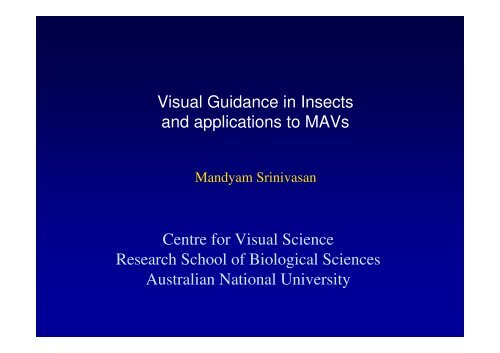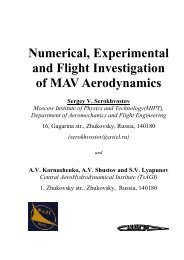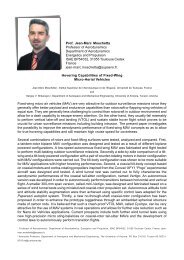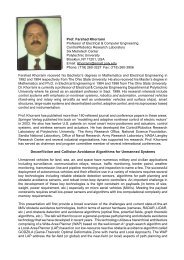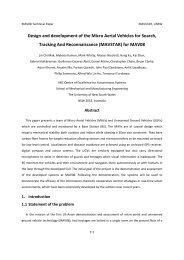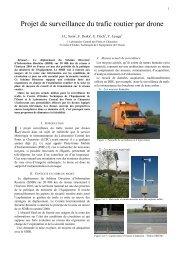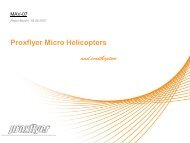Biol. Cybern
Biol. Cybern
Biol. Cybern
You also want an ePaper? Increase the reach of your titles
YUMPU automatically turns print PDFs into web optimized ePapers that Google loves.
Visual Guidance in Insects<br />
and applications to MAVs<br />
Mandyam Srinivasan<br />
Centre for Visual Science<br />
Research School of <strong>Biol</strong>ogical Sciences<br />
Australian National University
Bees negotiate narrow gaps by balancing the image velocities in the two eyes<br />
Kirchner & Srinivasan<br />
Naturwissenschaften (1988)<br />
Srinivasan, Lehrer, Kirchner & Zhang<br />
Vis. Neurosci. (1991)
Indoor tunnel: AWBFF
Transient change of optic flow: static to moving<br />
Baird, Srinivasan & Zhang, JEB 2005
Control of flight speed<br />
Speed of flight is regulated<br />
by holding the global<br />
image velocity constant<br />
Srinivasan, Zhang, Lehrer & Collett<br />
J. Exp. <strong>Biol</strong>. (1996)
Landing<br />
How does a bee perform a smooth, grazing landing on a horizontal surface ?
Filming trajectories of landing bees in 3-d<br />
h<br />
d<br />
h α d
Typical landing trajectory<br />
16 cm<br />
22 cm
Reconstruction of landing trajectories in 3d<br />
Srinivasan, Zhang, Chahl, Barth & Venkatesh, <strong>Biol</strong>. <strong>Cybern</strong>. (2000)
h<br />
(height above<br />
surface)<br />
Landing parameters<br />
V d<br />
V f<br />
(Descent speed)<br />
(Forward speed)<br />
θ (Descent angle)<br />
θ=Tan -1<br />
Flight direction<br />
V f<br />
V d
Horizontal flight speed versus height<br />
Srinivasan, Zhang, Chahl, Barth & Venkatesh, <strong>Biol</strong>. <strong>Cybern</strong> (2000)
1.<br />
2.<br />
Rules for landing<br />
Ground image speed is held constant<br />
V f<br />
ω<br />
( t)<br />
= . h(<br />
t)<br />
Instantaneous descent speed Vd(t) is coupled to<br />
instantaneous forward flight speed Vf(t):<br />
dh(<br />
t)<br />
( t)<br />
=<br />
− = B.<br />
V ( t)<br />
dt<br />
Vd f
Rules for landing<br />
• Forward flight speed V f (t)<br />
is proportional to instantaneous height h(t)<br />
above ground:<br />
V f<br />
( t)<br />
ω.<br />
h(<br />
t)<br />
= (1)<br />
whereω is the angular velocity of the image in radians/sec.<br />
• Make descent speed Vd (t)<br />
proportional to forward flight speed V f (t)<br />
:<br />
Inserting (1) into (2),<br />
which can be solved for h (t)<br />
dh(<br />
t)<br />
( t)<br />
− = B.<br />
V ( t)<br />
dt<br />
= (2)<br />
Vd f<br />
dh(<br />
t)<br />
. . h(<br />
t)<br />
+ = 0<br />
dt<br />
B ω (3)<br />
to yield<br />
h(<br />
t)<br />
= h(<br />
t ). e<br />
0<br />
−ω.<br />
B.(<br />
t −t<br />
where h t ) is the height at the initial time<br />
( 0<br />
0<br />
)<br />
t = to<br />
.<br />
Height decreases exponentially with time<br />
(4)<br />
Inserting (4) into (1),<br />
V<br />
( t)<br />
= ω.<br />
h(<br />
t ). e<br />
f<br />
(5)<br />
0<br />
−ω<br />
. B.(<br />
t−<br />
t<br />
Forward speed decreases exponentially with time<br />
Inserting (5) into (2),<br />
V ( t)<br />
= B.<br />
ω.<br />
h(<br />
t ). e<br />
d<br />
(6)<br />
0<br />
0<br />
)<br />
−ω<br />
. B.(<br />
t −t<br />
Descent speed also decreases exponentially with time<br />
Dividing (6) by (5),<br />
V ( t)<br />
V ( t)<br />
f<br />
(7)<br />
as required by the descent constraint.<br />
d =<br />
• Cumulative horizontal distance travelled (Hordist ) :<br />
Hordist =<br />
t<br />
t0<br />
Integrating, we get<br />
V ( t).<br />
dt =<br />
f<br />
t<br />
t0<br />
B<br />
ω.<br />
h(<br />
t ). e<br />
0<br />
−ω<br />
. B.(<br />
t−t0<br />
)<br />
[ ] ) .( . −ω<br />
B t−<br />
1−<br />
e<br />
h(<br />
t )<br />
t<br />
Hordist = .<br />
B<br />
(9)<br />
0 0<br />
. dt<br />
Horizontal distance travelled is a saturating exponential function of<br />
time<br />
0<br />
)<br />
(8)
Model prediction 1:<br />
h(<br />
t)<br />
=<br />
h(<br />
t0).<br />
e<br />
−ω<br />
. B.<br />
t<br />
Height decreases exponentially with time
Test of prediction 1<br />
Srinivasan, Zhang, Chahl, Barth & Venkatesh, <strong>Biol</strong>. <strong>Cybern</strong> (2000)
Model prediction 2:<br />
Hordist<br />
=<br />
h(<br />
t ) 0 . 1<br />
ω<br />
B<br />
[ ] t B<br />
− e<br />
− . .<br />
Cumulative horizontal distance travelled<br />
is a saturating exponential function of time
Test of Prediction 2<br />
Srinivasan, Zhang, Chahl, Barth & Venkatesh, <strong>Biol</strong>. <strong>Cybern</strong> (2000)
Projected time to touchdown<br />
TTT =<br />
1<br />
B.<br />
ω<br />
≅ 0.22 sec<br />
Is constant through the landing process!
Honeybee odometry<br />
The waggle dance<br />
Q: How does a bee work out how far she has flown?<br />
Waggle duration (sec)
Round dance<br />
(feeder distance < 50m)<br />
Waggle dance<br />
(feeder distance > 50m)
What distance do bees “perceive”<br />
when they fly inside a narrow tunnel?
Hive<br />
Hive<br />
Hive<br />
Srinivasan, Zhang, Altwein & Tautz, Science (2000)<br />
Esch, Zhang, Srinivasan & Tautz Nature (2001)<br />
Feeder<br />
6 m<br />
6 m<br />
Feeder<br />
Feeder<br />
6 m<br />
Dance signal<br />
Round dance<br />
~ 0 m<br />
Waggle dance<br />
~ 200 m<br />
Round dance<br />
~ 0 m
Tautz, Zhang, Spaethe, Brockmann, Aung Si, Srinivasan (PLOS <strong>Biol</strong>ogy, 2004)
Panoramic Imaging System<br />
Image acquired<br />
by camera<br />
Digitally unwarped<br />
panoramic image
Panoramic Imaging System<br />
The system comprises a standard<br />
video camera viewing a specially<br />
shaped reflective surface. The<br />
surface has the property that a<br />
given change in the angular<br />
elevation of view in the external<br />
environment maps to a constant<br />
radial displacement in the<br />
camera’s image<br />
Constraint equation<br />
for generating profile<br />
of panoramic imaging<br />
surface<br />
Chahl & Srinivasan, Applied Optics, 1997<br />
d<br />
dθ<br />
θ<br />
r<br />
αθ<br />
tan-1 (r dθ)<br />
dr<br />
= κ<br />
where κ = - (1+α)/2<br />
Sin[A-θ(1+α)/2]<br />
= (Br) (1-α)/2<br />
Constants of integration A and B are set by boundary conditions:<br />
distance r 0 and slope of surface at θ = 0
Gantry -based,<br />
insect-inspired<br />
navigation system<br />
emulates flight in<br />
realistic terrain<br />
Navigation in 3-D
Development and<br />
testing of<br />
algorithms for<br />
landing, terrain<br />
following, gorge<br />
following,<br />
obstacle avoidance<br />
and point-to-point<br />
navigation<br />
Chahl & Srinivasan (2000b)<br />
Navigation in 3-D(contd.)
Video TX<br />
GPS RX<br />
Video<br />
camera<br />
Helicopter System Overview<br />
Flight<br />
Computer<br />
(Hirobo Eagle-X)<br />
Vibration Isolator<br />
Inertial<br />
Sensors<br />
Video Antenna<br />
Magnetometers
View of<br />
helicopter<br />
Visually Stabilized Hover<br />
View from<br />
helicopter
Video<br />
Stream<br />
Optic Flow<br />
computation<br />
Remove<br />
image Σ -<br />
rotations<br />
X,Y<br />
Translation<br />
Range<br />
Calculation<br />
Desired<br />
altitude<br />
Ground<br />
Speed<br />
Forward Flight Controller Design<br />
Inertial Sensors GPS Magnetometers<br />
Gyro rates<br />
Height above<br />
ground<br />
+<br />
State Estimator<br />
Altitude<br />
-<br />
accelerations<br />
Σ<br />
Z<br />
Velocity<br />
Speed<br />
X<br />
Velocity<br />
Y<br />
Velocity<br />
PID<br />
Controller<br />
*<br />
- +<br />
Σ<br />
- +<br />
Σ<br />
Heading to<br />
achieve desired<br />
ground track<br />
Controls tail<br />
rotor pitch<br />
Desired Flight<br />
Speed<br />
Controls pitch<br />
attitude<br />
Controls roll<br />
attitude<br />
Controls<br />
collective pitch<br />
* GPS can be replaced with any<br />
suitable ground speed measure.
View from<br />
helicopter<br />
Field testing of forward flight controller<br />
Method adopted for testing forward flight algorithms<br />
on actual helicopter. A safety pilot observes from the<br />
back of the chase vehicle, poised to take control from<br />
the automatic controller for take off, landing and in<br />
case of an emergency.
Height above ground (m)<br />
3<br />
2.5<br />
2<br />
1.5<br />
1<br />
0.5<br />
0<br />
Flight test results for helicopter at 50 km/hr<br />
0 1 2 3 4 5<br />
Time (seconds)<br />
Height above ground<br />
calculated by optic flow<br />
Image from<br />
downward looking<br />
camera
a<br />
Hirobo<br />
Eagle-X<br />
b<br />
c<br />
Helicopter system<br />
d e<br />
Overview of one helicopter system showing (a) craft (ca. 1.5 m fuselage, 1600g payload), (b) video and telemetry<br />
transmitter (c) custom designed inertial sensor housing (d) in-house designed and patented panoramic optical<br />
system (e) in-flight panoramic image (f) flight computer<br />
f
Panoramic video imaging from helicopter
Features:<br />
• Panoramic<br />
stereo<br />
• Frontal stereo<br />
• Frontal mono to<br />
eliminate blind<br />
zone<br />
mm<br />
200<br />
150<br />
100<br />
50<br />
0<br />
-50<br />
-100<br />
-150<br />
Vision system for panoramic stereo<br />
-200 -150 -100 -50 0 50 100 150 200<br />
mm
Driven by an interest in understanding and applying biological principles,<br />
rather than outright biological mimicry
Shaowu Zhang<br />
Javaan Chahl
Funding<br />
Australian National University<br />
Australian Research Council<br />
Australian Defense Science and Technology Organisation (DSTO)<br />
International Human Frontiers Science Program (HFSP)<br />
U.S. Defense Advanced Research Projects Agency (DARPA)<br />
U.S. Air Force<br />
U.S. Office of Naval Research (ONR)<br />
U.S. National Aeronautics and Space Administration (NASA)<br />
Jet Propulsion Laboratory, Caltech (JPL)<br />
Australia-Germany Research Collaboration Grant<br />
U.S. Army Research Office
Thank you


